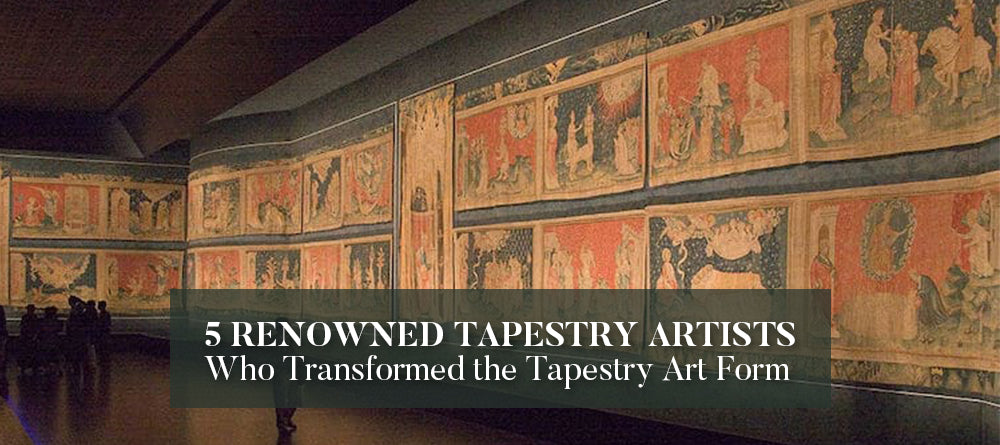
Introduction
For thousands of years, the art of tapestry has been practiced globally. The Egyptians first used these art pieces and Incas as burial shrouds. But in Europe, the Greeks and Romans started using them as wall coverings or hanging them like a picture on a wall. Meanwhile, the people in China used tapestries to decorate their clothing and wrap gifts.
But who made tapestry so famous worldwide? Below we have discussed five tapestry artists who have completely transformed the art form of tapestry. However, each of the artists has applied techniques that helped them to incorporate their special artistic touch.
In this blog post, we will be highlighting five tapestry artists who have transformed the tapestry art form globally and their works, which are valued even today.

Five Renowned Tapestry Artists
1. Franchos Bouchoir
François Boucher, a Parisian painter and engraver, was born into humble artistic roots. His early training was followed by his father before being noticed by the famous artist François Lemoyne. Boucher's skills were admired by collector Jean de Jullienne, and he was given the responsibility of engraving Antoine Watteau's drawings. At just 20, Boucher received the Prix de Rome, the highest honor at the Académie.
His journey as an artist started with royal and aristocratic collectors in high demand for his mythological scenes, genre paintings, landscapes, and portraits. His tapestry cartoons were highly valued and exported to China. Boucher's signature Rococo style was well-suited to decorative arts, and his designs were reproduced on porcelain. He also oversaw stage set designs for the royal opera.
Boucher worked mostly for the international and aristocratic elite in Paris, despite his varied projects. Louis XV's official chief mistress, Madame de Pompadour, emerged as his most significant client, hiring large-scale portraits and monumental works based on mythology. In 1765, Boucher was named Premier Peintre du Roi with her support.
2. William Moris
The creations of Willaim Moris have a major role in the resurgence of medieval tapestry art during the 19th century. The revival and popularity of medieval tapestries can be attributed to the arts movement, which was led by William Moris. Morris and his movement helped to bring back many ancient art forms including tapestries. His creations like "The Tree European Tapestry" or "The Tree of Life" are among his most well-known creations.
Having grown up in a prosperous family, Morris went to Exeter College in Oxford, England, following an uneventful upbringing. Morris always enjoyed art, particularly pre-renaissance pieces, but he didn't start his ambitious project to conserve and restore medieval art forms until he got to know painter Edward Burne-Jones. The Pre-Raphaelite Brotherhood was founded by Burne-Jones, Morris, and other students. This group of artists drew inspiration from Middle Ages art and culture.
3. Bayeux Tapestry Artist
Another revolutionary tapestry artist was the person who planned Bayeux's tapestry, which states the events leading up to the Norman Conquest of England in 1066. The tapestry stands for the outstanding brilliance of its creator. Although the names of the artists are a mystery to date, their contribution to making tapestry a popular and unique art form is unparalleled.
The artists have skillfully portrayed the scenes of battle, ceremony, and daily life. The artists can portray a complex narrative through the threads. The artists have left a lasting legacy and continue to inspire modern tapestry artists.
4. Lady and the Unicorn Tapestry Artist
The Lady and the Unicorn Tapestry is a set of six tapestries that were created during the late 15th century. These tapestries can captivate the minds of the viewers with their mystery and symbolism. The artists behind this series of tapestries have an exceptional contribution to the rise of medieval tapestries.
These tapestries, each indicating one of the five senses along with another tapestry named ‘To My Only Desire” show unique skill in composition and storytelling. The incorporation of symbolism and allegory in these tapestries has inspired other artists from that generation to the contemporary times.
5. Apocalypse Tapestry Artist
The 140-meter-long masterpiece known as the Apocalypse Tapestry bears witness to the supreme vision of its unidentified creator. Constructed during the 14th century, it portrays the biblical story of the Apocalypse with intense emotion and vivid detail. The generations of tapestry makers have benefited from the artist's storytelling and symbolism skills, which add to the rich tapestry created by humans.
Conclusion
In conclusion, tapestry art is deeply enrooted in history and continues to win the hearts and minds of audiences around the world. The contribution of the artists mentioned above in making the tapestry art form a popular one worldwide is significant. They have developed a legacy for the upcoming generations of artists.
Visit Home Decor Tapestries, and you will get a huge collection of historical tapestries designed by these famous artists.
Browse Our Other Blogs
- How to Hang a Tapestry Without Nails: 7 Easy Tips
- Unraveling Medieval Tapestries: A Concise History
- How to Decorate Your Room with Wall Hanging Tapestries: 5 Easy Steps
- How To Clean Tapestry Wall Hanging? Maintenance & Preservation Tips for Longevity
- Step-by-Step Guide: Hanging Tapestries on Walls the Right Way
- Why Tapestry Is Often Pricier Than Traditional Art: Top 5 Reasons
